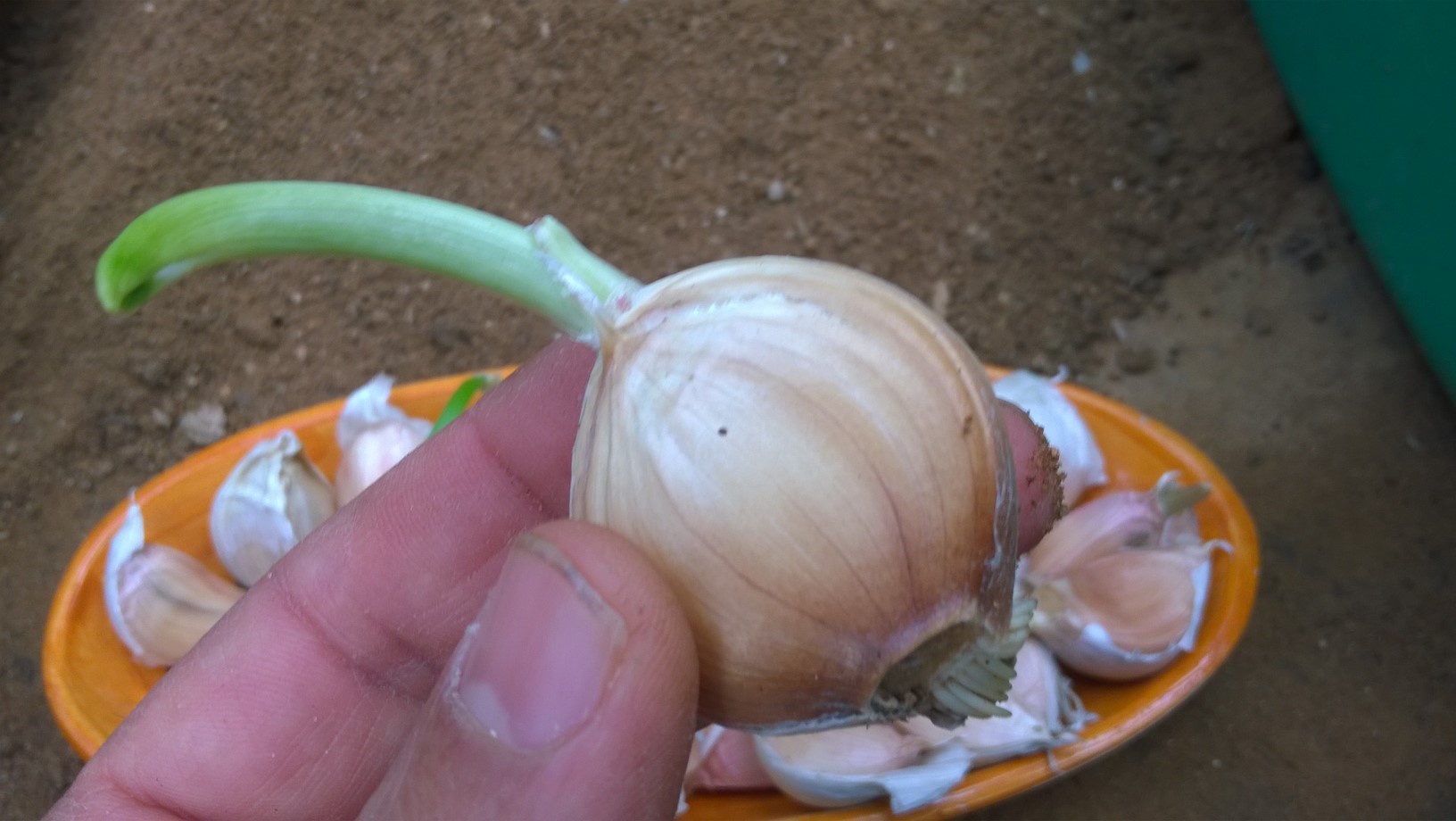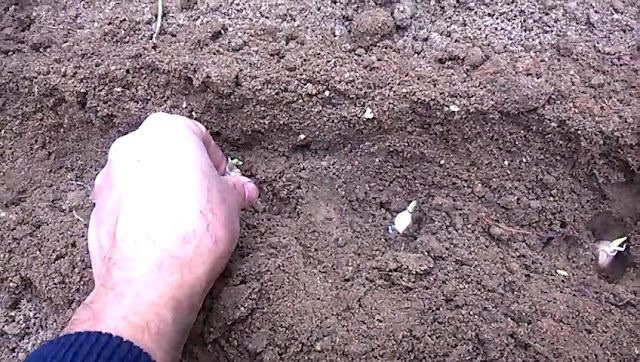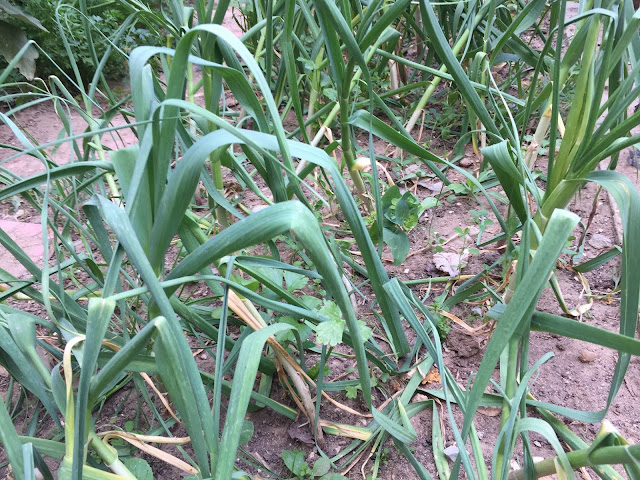Grown for its flavourful bulbs. Garlic is easy to grow and requires very little space in the garden. A member of the allium family. The Allium Genus is the family of plants that includes garlic, onions, and leeks. Garlic grows from individual cloves broken off from a whole bulb. Each clove will multiply in the ground, forming a new bulb that consists of 5-10 cloves.
. Garlic Varieties.
There are many varieties of garlic that can be planted and are great for making tasty dishes and improving health. Once you have decided which garlic you will grow, and how much, you can begin to plant and enjoy all its benefits. The most important when growing organic garlic is to get the largest bulbs possible.
Hardneck
Hardneck garlic is extremely cold hardy, so opt to grow this variety if your winters are harsh.
Softneck
Softneck garlic is found at most supermarkets. It has a relatively mild flavor. This variety, is especially recommended for those in warmer climes. This kind of garlic don't develop a flowering stalk, so their stems stay soft and flexible. These varieties store very well, making it ideal for mass production. The heads of softneck garlic can be stored for nine to twelve months under ideal storage conditions. This garlic is the best choice for regions with mild winters.
There are a lot of decisions to make when choosing garlic! Hardneck or Softneck, many cloves or few, mild flavor or spicy! The question is which type of garlic to plant and how? Once you have decided which garlic you will grow, and how much, you can begin to purchase garlic to grow, and enjoy all its benefits.
When purchasing garlic, always make sure you choose seeds from good sources and realize that as you will use these seeds through multiple growing seasons and their yields will improve over time.
You can check out this big list of various types and high quality of garlic that are perfect for growing in your garden!
By following these simple tasks, you will enjoy planting, growing and harvesting your own garlic at home.
When planting garlic cloves:
The dates of planting garlic cloves vary widely. To grow big garlic bulbs, you can typically plant the cloves in late autumn. As garlic roots develop during the fall and winter, before the ground freezes, and by early spring, they start producing foliage. Then, you’ll harvest big bulbs in the summer.
Where to Plant Garlic Cloves:
Choose a location with full sun, that receives at least 6 hours of direct sunlight per day. Garlic cloves should be planted in an area not recently used for garlic or other plants from the onion family. Never plant your garlic in areas where the water can collect around the roots, this will cause them to rot or become diseased, and you will lose your garlic!
Soil Preparation for Planting Garlic cloves:
Garlic cloves should be planted in a fertile, well-drained soil. Work several inches of compost or well-rotted chicken manure into the soil before planting.
. How to Plant Garlic cloves.
Planting the cloves is relatively simple.
. Break a garlic bulb apart into individual cloves, be careful to keep the papery skins covering each clove intact, examine each bulb carefully and remove any bulbs that display mold or abnormalities that may indicate disease.
. Select the biggest, and firmest, bulbs with the biggest cloves. Big, healthy cloves will produce big heads of garlic!
. Cover the cloves with 2 inches of soil water well, after planting lay down a protective mulch of straw, chopped leaves or grass clippings. Mulch will help to prevent the garlic roots from being heaved out of the ground by alternate freezing and thawing.
Watch How to plant Garlic Bulbs Video
. Garlic Plant Care.
When the leaves begin to grow, it is important to feed the garlic plants to encourage good growth.
. If the mulch has decomposed, add a layer to help retain moisture and keep weeds under control.
. In late spring some garlic varieties produce flower stalks that have small bulbs. Cut these stalks off. This will ensure that all the food the plant produces will go into the garlic bulb itself and not the clusters of bulbs.
You can use composted chicken manure to fertilize garlic as composted chicken manure not only helps to build the health of the soil by adding organic matter and increasing water holding capacity, but it also acts as a fantastic fertilizer adding vital nutrients like nitrogen, phosphorus, and potassium to your garlic plants.
. Watch How to Fertilize Garlic Video.
. Garlic Pests And Diseases.
Garlic has very few problems with pests, but there are however two diseases which you may find on your garlic crop Rust and White rot.
Rust appears as rusty colored spots on the leaves, and the only cure apart is avoiding growing garlic in the same place for 3 years.
White rot, which decays the roots and eventually the bulb. White rot is a fungus that attack garlic in cool weather. The spores can live in the soil for many years. The fungus affects the base of the leaves and roots. Just make crop rotation.
. How To Harvest Garlic.
Knowing when to harvest garlic is so important. Harvest time depends on when you plant so it is best to check upon your plants regularly. In warmer climates, you can begin to harvest garlic as early as spring. Once the tops of garlic plants start to die back, and you see the leaves starting to decline you know it’s time to harvest. When you see the leaves starting to decline, stop watering. This dry spell will help to cure the garlic.
Harvesting too soon will result in smaller cloves that don’t store well and leaving the bulbs in the ground too long causes the cloves to burst out of their skins, making them unstorable and vulnerable to disease so you have to harvest your garlic when the tops begin to yellow and fall over, before they are completely dry.
You can check up on one or two plants, to see if the bulbs are big enough. Just remove a bit of soil around the stalk to get a good look and when the bulb is big enough and you are satisfied with the size, you should proceed with the harvest. If not, then you can wait a bit more, but when about half of the leaves are brown, you should dig out all of your garlic, no matter the size.
. Lift the bulbs with a spade and be careful not to dig too close to the heads.
You can check up on one or two plants, to see if the bulbs are big enough. Just remove a bit of soil around the stalk to get a good look and when the bulb is big enough and you are satisfied with the size, you should proceed with the harvest. If not, then you can wait a bit more, but when about half of the leaves are brown, you should dig out all of your garlic, no matter the size.
. Lift the bulbs with a spade and be careful not to dig too close to the heads.
. How To Cure And Store Garlic.
Once the bulbs are cured the skins will be papery and dry. You have to check for any diseased, damaged or bruised bulbs and remove them. It is also a good time to select the bulbs you want to use for replanting. Choose the best and the healthiest, put them aside and store them separately from the bulbs to be consumed. Remember, do not keep the bulbs in a position where they get very hot or very cold. The optimum storage temperature for bulbs for replanting is 10°C, with limits of 5°C and 18°C. Garlic bulbs may be stored individually with the tops removed, or the dried tops may be braided together to make a garlic braid to hang in the kitchen or storage room.
Hope this was helpful, happy gardening!
Now that you know how to grow garlic, try to grow your own and enjoy an endless supply of one of the world's healthiest foods!
Garlic Bulbs Are Available HERE
. Affiliate Disclosure.
This blog post contains affiliate links to products on Amazon. This means that if you click on one of these links and make a purchase, we may earn a small commission. This commission comes at no additional cost to you but helps support the creation of valuable content for our readers.
The inclusion of affiliate links is a way for us to earn a modest compensation for the time and effort invested in researching, curating, and presenting information. It's important to note that the products recommended in this blog post are chosen based on their perceived value, relevance to the content, and positive reviews, not solely on the potential for earning commissions.
We want to assure our readers that our primary goal is to provide informative and unbiased content. The presence of affiliate links does not influence the editorial integrity of our recommendations. We only endorse products that we genuinely believe may bring value to our audience.
Please be aware that individual experiences with products may vary, and it's advisable to conduct personal research or consult customer reviews before making a purchase decision. Your support through the use of affiliate links is greatly appreciated and contributes to the sustainability of our efforts to provide quality content.
If you have any questions or concerns regarding the affiliate links in this blog post, feel free to reach out to us. We value transparency and aim to maintain the trust of our readers.















